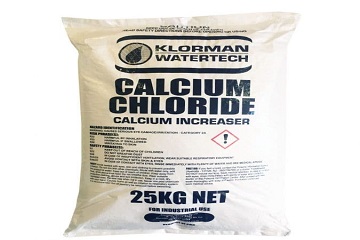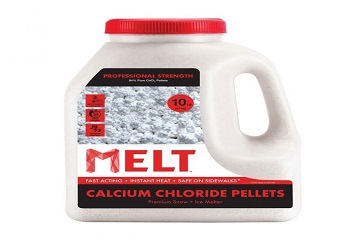Calcium chloride is a concrete admixture. It works as an accelerator. This blog article explains use of calcium chloride in concrete as an accelerator.
Table of Contents
Introduction
Calcium chloride is used as an accelerator in the hydration process of cement. Calcium chlorides decrease the setting time of concrete and lead to the quick settlement of concrete to get high initial strength of concrete.
2% calcium chloride can add as a maximum permissible limit in concrete.
Methods to add Calcium Chloride
Calcium chloride is available in different forms like pellets, granules, flakes, or in solution form. The regular flake form contains a minimum of 78% calcium chloride and the pellet and other granular forms contain a minimum of 93%. As we know, all forms of calcium chloride are soluble in water, it is recommended to use Calcium Chloride in solution form.


The solution of calcium chloride should not bring in direct contact with cement, as it can lead to a quick setting of cement. Calcium chloride should be diluted in water and mixed with aggregate.
Effects of Calcium Chloride on Properties of Concrete
1. Effect on Physical Properties of concrete
Setting Time:
As calcium chloride is widely used as an accelerator in concrete, it significantly decreases the initial setting time and final setting time of concrete. It is normally used in low temperatures as it permits rapid finishing and earlier use of slabs. The use of a calcium chloride accelerator is not recommended in hot weather as it sets the concrete very quickly and makes it very difficult to place and finish the concreting process.
As per CSA A266.2-1973 and ASTM C494-1971 standards, the initial setting time of calcium chloride should occur at least 1 hour before (but no more than 3 hours [CSA] or 3.5 hours [ASTM]) with respect to the reference concrete.
Water Cement Ratio:
Calcium chloride does not significantly decrease the water required to produce a given slump and this factor is not expected to play an important role in the strengthening process of concrete. Calcium chloride may tend to induce early stiffening and hence reduce bleeding.
Air Entrainment:
Utilization of calcium chloride in the concrete does not cause entrainment of air, however, when used with air-entraining agents, it facilitates in producing more air content in less quantity of the air-entraining agent.
Freezing and Thawing:
Concrete containing calcium chloride hardens quickly and develops early resistance to damage by freezing and thawing. It is very important in winter concreting when the material can be subjected to the early application of de-icing salts. At later ages, the matured concrete containing calcium chloride accelerator can be less resistant to frost attack.
Dry Shrinkage:
It is known to increase drying shrinkage, the magnitude depends on the quantity of calcium chloride added, type of cement, time period of curing, and environmental conditions.
Efflorescence:
Because of the utilization of calcium chloride in concrete, a whitish deposit is formed on the cured concrete surface in some instances. Under normal conditions of exposure, it attracts water and is not much likely to cause efflorescence as other salts do. As these whitish deposits are not soluble in water, so dilute hydrochloric acid is used to remove them.
2. Effects on Chemical Properties of Concrete
Sulphate Attack:
Calcium chloride has a deterioration impact on the concrete when it is exposed to solutions of sulphates. The sulphates react with calcium and aluminium ions in the cement paste to make calcium sulphate and calcium sulphoaluminate hydrates, accounting for disruption of the concrete. If calcium chloride is present, there is evidence that resistance to sulphate attack is decreased.
Heat of Hydration:
The heat of hydration is at a faster rate and the hydration process is quicker in the presence of calcium chloride, especially in the first 10 to 12 hours. The total amount formed is not much changed, but its early development may be beneficial in winter concreting.
Alkali-Aggregate Reaction:
When the high alkali cement is used with some types of aggregates, deterioration of concrete occurs due to aggregate swelling. It is realized that the calcium chloride in concrete aggravates the alkali-aggregate reaction. If calcium chloride has to be used in such conditions expansion may be controlled by the use of low alkali cement, pozzolana, or a non-reactive aggregate.
Corrosion of Reinforcement Steel:
In concrete containing calcium chloride, these steady shields that protect the steel from the external environment cannot be maintained with the same efficiency, and potential for corrosion exists.
Calcium chloride is restricted for prestressed concretes as the corrosion rate is more due to the surface area of the wires being large and stress differences being greater. Calcium chloride is not advocated for vapour cured concreting.
3. Effects on Mechanical Behavior
Compressive Strength:
As calcium chloride is used as an accelerator in the concrete, it increases the hardening rate of the concrete. ASTM C-494 requires an increase of at least 125% over the control concrete at 3 days, but at 6 months or one year, the requirement is only 90% of the control specimen.
In comparison with conventional concrete and calcium chloride concrete, strength gain may vary between 30 and 100% in the first 3 days. Quantity of calcium chloride in excess of accepted standards causes lower strengths. For the same quantity of chloride, strength increases are larger for richer mixes.
The impact of calcium chloride on the percentage gain in strength is particularly significant at lower temperatures.
Flexural Strength:
Flexural strength does not increase to such an extent as compressive strength with the addition of calcium chloride. ASTM C-494 requires that flexural strength at three days should be at least 110% of the control specimen. After long periods of time of curing the flexural strength of concrete containing calcium chloride may even be lower than that of the control specimen.
Shrinkage and Creep:
The addition of calcium chloride as an accelerator in concrete increases the shrinkage of concrete, which in turn increases the creep in the concrete.
Advantages of Using Calcium Chloride in Concrete:
- The initial strength of concrete is high by using calcium chloride.
- Calcium Chloride reduced the final setting time of concrete.
- It Reduced bleeding in concrete.
- It improved the workability of freshly mixed concrete.
- Because concrete set very fast, formwork removal time can be reduced.
- Calcium Chloride is cheap and easily available in the local market.
- Useful when used with fly ash.
